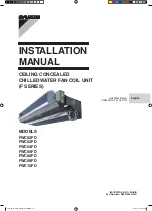
Principles of operation
4-5
Leak adaptation
Noninvasive ventilation in particular may involve considerable leakage around
the mask or through the mouth. Some leakage is known or intentional: it is a
characteristic of the mask/patient interface design. So that it can accurately
adjust its baseline flow, the ventilator has you enter the intentional leakage
value specific to the mask/patient interface (“Selecting the mask and
exhalation port” on page 6-12). Other leakage is unpredictable or
unintentional, and it changes as the patient’s breathing pattern changes.
To maintain prescribed pressures in the presence of leakage, the ventilator
adjusts its baseline flow. Because the unintentional part of the leakage may
constantly change, the ventilator recalculates the baseline flow each breath at
the end of exhalation. The ventilator uses two main mechanisms to update its
baseline flow: expiratory flow adjustment and tidal volume adjustment.
Expiratory flow adjustment. Every breath, at end-exhalation, the ventilator
updates its flow baseline. At end-exhalation patient flow is assumed to be zero,
so any difference between actual patient flow and the original baseline flow
indicates a change in leakage. Figure 4-4 shows how the ventilator adjusts the
baseline.
Figure 4-4: Expiratory flow adjustment
Flow
TIME
Original
baseline
Inspiration
Spontaneous
trigger
Cycle to
exhalation
End exhalation
Adjustment
of baseline
New
baseline
Patient
flow
Additional
leak
Summary of Contents for Respironics V60
Page 1: ...Respironics V60 V60 Plus Ventilator User Manual ...
Page 2: ......
Page 8: ...viii ...
Page 28: ...2 10 Symbols ...
Page 44: ...3 16 General information ...
Page 60: ...4 16 Principles of operation ...
Page 74: ...5 14 Setting up the ventilator for use ...
Page 102: ...6 28 Operation ...
Page 110: ...7 8 High flow therapy ...
Page 114: ...8 4 Patient monitoring ...
Page 132: ...9 18 Alarms messages and troubleshooting ...
Page 142: ...10 10 Care and maintenance ...
Page 162: ...A 10 First time installation ...
Page 182: ...D 10 Regulatory compliance ...
Page 198: ...E 16 Diagnostic mode ...
Page 210: ...Index Index 6 ...
Page 211: ......















































